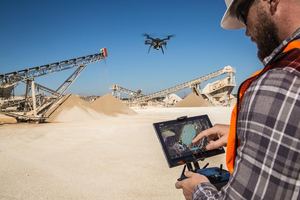BERKELEY, CA--(Marketwired - Aug 29, 2016) - With Part 107, the leaders of 3DR, North America's largest manufacturer of drone technologies for commercial and industrial markets, are excited to see that the FAA has greatly lowered the barrier to entry for flying drones to complete commercial work. In creating Part 107, the FAA worked closely with the Advisory Review Committee (ARC) led by an executive at 3DR as well as other industry leaders. Through this relationship and the recognition that commercial drones fly mostly autonomously and are controlled with apps not joysticks, the FAA concluded that a regular pilot's license is not necessary to safely fly commercial projects. It is the same trend businesses are seeing: small drones offer real value in many industries and as a work tool; we are safer and more productive with them than without them.
The Part 107 Rule is a major advancement in the liberalization of the skies for small, autonomous vehicles and it sets an excellent foundation for future regulations as well. With Part 107 the FAA is encouraging the commercial drone operation at scale and anticipating huge economic impact. With time, the empirical data collected will provide an opportunity to lower the regulatory barriers even further for the smallest class of drones, the micro category, which are inherently safer.
3DR CEO Chris Anderson explains, "This "micro category" could someday allow a "sandbox" approach like what the FCC used to open the airwaves for WiFi and other open-spectrum wireless technology. That created a huge industry and changed the world -- a precedent that bodes well for the future of commercial drones, too. Just as WiFi accelerated productivity inside the office, so too will commercial drones dramatically improve the productivity and safety of construction sites, mining and surveying."
The new regulations outline a common sense approach to commercial drone usage that requires individuals pass a knowledge exam and adhere to rules such as no flying at night and no "drinking and droning." It does not allow flight beyond visual line of sight - an important distinction and recognition that there is minimal risk in flying drones over construction sites, mining operations and natural resources.
To leaders in the construction, mining, and surveying industry, this is the signal they've been waiting for -- it is now easy and affordable to safely and legally fly drones for commercial purposes. In such industries where margins are continuously shrinking and worker safety is consistently a top priority, drones deliver advanced situational awareness, identifying easily avoidable problems earlier, and require fewer people on a site to collect and analyze valuable data to accelerate their performance. Leaders from innovative companies who have looked at drone usage in the past, but found the Sec 333 process too cumbersome, are recognizing that now is time to invest, and the FAA is anticipating dramatic investment. To give a sense of the scale, the FAA was able to offer a little over 5,000 exemptions to fly drones commercial with Sec 333. They now estimate that over 600K drones will be sold in 2016 because of the introduction of Part 107.
3DR strongly advocates that more people take the Remote Pilot Certification exam. The test is a mix of common sense and aeronautical questions designed to ensure everyone's safety. Below is 3DR's offering of resources designed to prepare potential pilots for the exam.
- FAA Drone Rules: Your all-in-one guide featuring all the test resources needed for taking the exam
- Practice Exam: An interactive practice exam featuring questions from the FAA practice test and more
- Where to Take the Exam: A map to help you find locations where you can take the test
- Expert Study Guide: A study guide compiled by a former commercial pilot with 10 years of experience teaching preparation courses for FAA exams
About 3DR
3DR makes advanced drone technology easily accessible to the construction, mining and surveying industries for use in mapping, 3D modeling, data analysis and more. 3DR's flagship enterprise product Site Scan™ is a complete camera-to app-to cloud system that makes it safer and easier than ever for enterprise and commercial users to capture and analyze aerial data and improve business operations. For more information on 3DR, please visit 3DR.com.
Contact Information:
Contact Info
Nicholas Porter
415-399-0181
